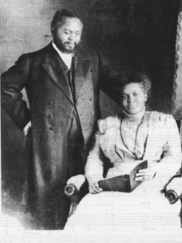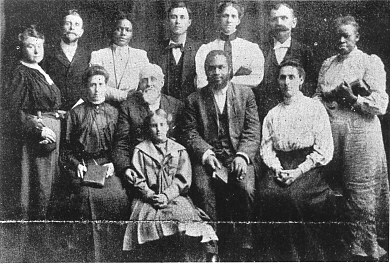Church history: William Seymour and the Rise of Pentecostalism
April 2006 was the 100th anniversary of a momentous revolution in Christianity that began at 312 Azusa Street in a ramshackle part of downtown Los Angeles. A writer for a local newspaper captured the significance of the Azusa Street Revival when he noted that it is “now seen as the great awakening of the Pentecostal / Charismatic movement.”1
 The pastor at the Azusa Street church was William J. Seymour (1870-1922). Seymour, the son of former slaves, had been raised as a Baptist and later joined a radical Holiness church. There he came to believe in divine healing, the rapture of the saints and Premillennialism, justification by faith and “sanctification as a second work of grace.”2
The pastor at the Azusa Street church was William J. Seymour (1870-1922). Seymour, the son of former slaves, had been raised as a Baptist and later joined a radical Holiness church. There he came to believe in divine healing, the rapture of the saints and Premillennialism, justification by faith and “sanctification as a second work of grace.”2
Seymour had also been a follower of a Holiness preacher named Charles Fox Parham (1873-1929). He attended Parham’s Bible school in Houston, Texas, where he was taught the idea that tongues-speaking is the biblical evidence of being baptized in the Holy Spirit.
Seymour came to Los Angeles, where he was invited to minister to a house church on North Bonnie Brae Street. It was here that a defining event happened during a worship service on April 9, 1906. A member of the small group suddenly spoke in “tongues.” Then, in a chain reaction, other members at Bonnie Brae also became tongues-speakers.
This led to much notoriety and a crush of new worshippers filling the small church. It forced Seymour to relocate his congregation to a larger building on Azusa Street in what is today the Little Tokyo section of Los Angeles. The new church was called the “Apostolic Faith Gospel Mission.” Here the revival grew into a crescendo as more and more people began to speak in tongues.

The Apostolic Faith, the Azusa Street congregation’s newspaper, trumpeted the group’s growing belief that tongues-speaking was a sign that all the gifts of the Spirit had been restored to the church. A headline in the paper’s first issue (September 1906) proclaimed: “Pentecost Has Come. Los Angeles Being Visited by a Revival of Bible Salvation and Pentecost as Recorded in the Book of Acts.”3
The local revival sown on Azusa Street became the seed-bed of an international Christian movement. Over the next three years, hundreds of people worshipped there, many speaking in tongues, and revolutionized Christianity in several ways:
- During a time of rampant segregation and discrimination, the Azusa Street congregation was multiracial. African-Americans, Anglos, Hispanics, and Christians of other ethnic backgrounds freely mingled, worshipped together and shared leadership.
- A missionary fervor characterized the Azusa Street worshippers and those who had joined with them. Many members of the Azusa group streamed out across America and into other lands to preach the gospel. This evangelistic fervor would lead to a worldwide explosion in Pentecostalism.
- The Azusa Street revivalists possessed a deep-seated belief that all the supernatural gifts of the Spirit had been dispensed to believers so they could preach Christ’s gospel and build his church.
Speaking in tongues, faith healing, fervent prayer, emotional, from-the-heart participatory worship and stress on evangelism became the hallmarks of the Azusa Street experience. These traits appealed to many Christians and seekers. Pentecostalism’s influence began to be felt in non-Pentecostal churches and denominations. The Charismatic movement developed out of this worship and stress on the work of the Holy Spirit.
Today, the number of classical Pentecostals worldwide and those who are considered Pentecostal-like charismatics has exploded. Because of a fervent missionary zeal, it has become one of the fastest-growing Christian movements in South America and Africa. The Dictionary of Christianity in America cites Pentecostalism as being “perhaps the single-most-significant development in twentieth-century Christianity.”4
For the most part, Pentecostalism has been considered a movement of the poor and m marginalized people of the world, and that has been true up to a point. However, it has also made dramatic inroads into mainstream and mainline Western Christianity. Because of Pentecostalism and the Charismatic Movement, all Christians have had to consider more deeply the role of the Holy Spirit in the life of the Christian and in Christian mission around the world.
Endnotes
1 Andrew Moyle, “A Century of Faith: Event Celebrates 100th Anniversary of Azusa Street Revival,” Downtown News, April 24, 2006, page 7.
2 Vinson Synan, “Introduction,” in Frank Bartleman, Azusa Street: The Roots of Modern-day Pentecost (Plainfield, NJ: Logos International, 1980) page ix.
3 “The Apostolic Faith,” vol. 1, no. 1, Sept. 1906.
4 Roger G. Robins, “Pentecostal Movement,” in Dictionary of Christianity in America (Daniel G. Reid, ed.; Downers Grove, IL: InterVarsity Press, 1990), page 885.
Author: Paul Kroll

